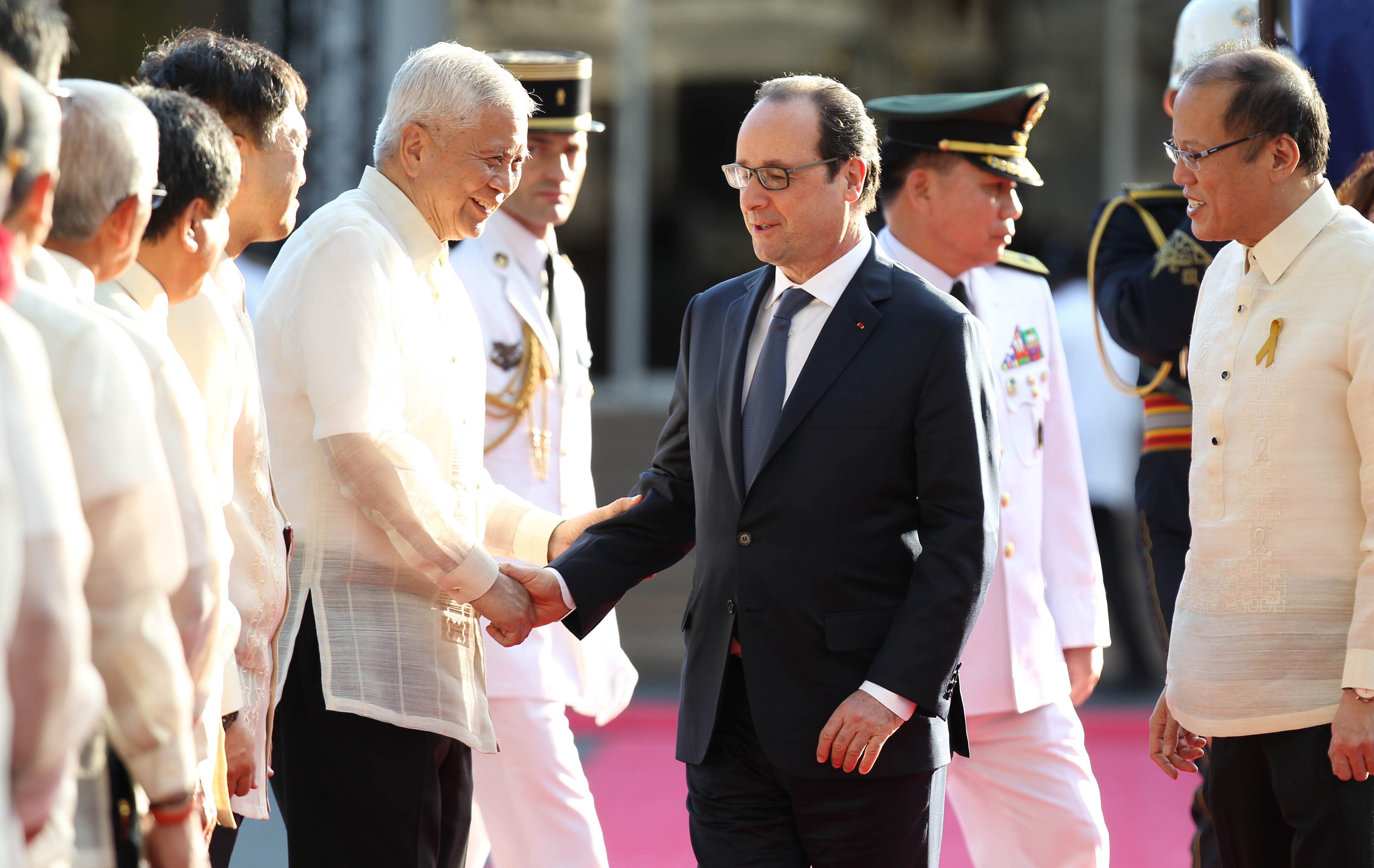SUMMARY
This is AI generated summarization, which may have errors. For context, always refer to the full article.
 The contemporary fascination of France with the Philippines reincarnates the sense of awe of naturalist Antoine-Alfred Marche when he came to explore our islands in 1881.
The contemporary fascination of France with the Philippines reincarnates the sense of awe of naturalist Antoine-Alfred Marche when he came to explore our islands in 1881.
For sure, the natural beauty of its landscapes and its remarkable cultural richness, which Marche described in vivid, colourful detail, are very much still there, but the nature of the odds that people face have no doubt become far more intricately complex.
The visit of French President Francois Hollande on Friday, February 27, in Guiuan, Eastern Samar – ground zero of Super Typhoon Haiyan (Yolanda) – eerily calls to mind a cataclysmic storm in 1881 which claimed 20,000 lives in the Philippines alone (which also killed 300,000 in Vietnam, a territory which France will later on colonize).
Like Marche before him, President Hollande will marvel at the Filipinos’ joie de vivre, its indomitable resilience despite the seemingly insurmountable odds.
The cost
This sense of resilience has been and continues to be tested with the procession of freak weather events that have hit the country in the last 5 years. Over the last 5 years, disaster tolls have risen by 175%. The tolls on GDP and crop yields have been 30% largely due to rising temperatures and flooding.
But thanks to the support of the Australian Department of Foreign Affairs and Trade (DFAT), Oxfam is now beginning to crack the code to building resilience, in an effort to address both the rapid- and slow-onset impacts of climate change, particularly in rural agricultural communities.
With $260, we can develop the capability of a group of seaweed farmers to measure water salinity with precision. Add U$5, a seaweed farmer can fully recover from a crippling loss such as Typhoon Bopha (Pablo) which obliterated this major source of income for Hinatuan town, Surigao del Sur. The town went on to become the lighthouse of disaster management in the country.
For a small sum of $785 we can setup a community early warning system which include access to weather broadcasts, signages on evacuation routes, warning signs installed in hazard prone areas, and water level gauges to monitor rise of water in river banks.
With just about $942 local communities can formulate disaster contingency plans, conduct drills and simulations and village level education sessions on disasters and climate change. With $1,570 we can train and equip the communities with emergency response skills including basic life support and first aid, mountain and water search and rescue.
For $2,510 we can build the capacity of local governments to generate localized, highly reliable 7 day weather forecasts which includes the weather instruments connected to computers. The importance of local forecast was evident in Jabonga, Agusan del Sur with onslaught of tropical storm Agaton in 2014. With the aid of the weather station that was setup with the help of Oxfam and the weather bureau PAGASA, the local government had a good estimate of how intense the rainfall would be, for how long and how fast the flood would rise.
“By the time Agaton poured its might, most of the highly at-risk families were already in the evacuation centers. The result was nothing short of astonishing-zero casualties-in view of Agaton’s vaunted strength,” recalls Georgette Manoy, head of the Jabonga disaster operations center.
For $3,545 we can build local capacity to mitigate soil erosion, landslide and flooding through bamboo replanting, gabion river-bank control, and framers’ training on sloping land technologies.
Add another $1,257, we can teach a community of farmers with climate-smart farming technologies with which they could grow resilient, high value crops, manufacture their own farm inputs, and open up the local market for their products.
Resilience, reality

We are beginning to understand that resilience is less about building the community to bounce back from shocks whenever disaster happens, because considering their pre-existing vulnerabilities, it won’t be enough to thrust them forward. We need to aim for that state where the communities can bounce forward, to thrive and prosper and beat the climate odds. This requires establishing climate adaptation and risk reduction programmes such as these across the country – at speed and at scale – and investing adequate amounts of public resources to start them up.
In August 2012, the Philippine Congress passed a law establishing the People’s Survival Fund (PSF), a national climate fund meant to financially support climate adaptation initiatives. More than just a law meant to address the impacts of climate change, it is also a political statement being made by a vulnerable developing country, given the agonizingly slow progress in international climate negotiations – a statement in light of very low ambitions, in both emissions reduction and climate finance, that developed country parties have shown over years of talking. That, given the urgency of the situation, and the devastating impacts we are already suffering, we simply couldn’t wait and do nothing.
The Philippine government has been investing significantly in adaptation and risk reduction from its own resources, and has recently allocated P1 billion (roughly $23 million) for local climate adaptation initiatives under the Peoples Survival Fund (PSF) for the current fiscal year. This is apart from the P13 billion currently allocated for the National Disaster Risk Reduction Management Fund (NDRRMF). Yet again, for a country located at the edge of the Pacific Ocean where extreme storms are made, nothing will be quite enough. Haiyan, which is just one extreme event, has cost us an estimated $12-15 billion in terms of economic losses in 2013.
Inflows from the $100 billion pledge of developed countries which they made in Copenhagen in 2009 remains a pittance. Of the $30 billion they committed to disburse from 2010-2012, less than 20% went to adaptation. We need the political astuteness of French President Hollande – incoming President of the 21st Conference of Parties of the UNFCCC – to close this yawning gap in adaptation financing under the new agreement that the Paris CoP is expected to deliver in December 2015. For countries at high risk of climate change impacts like the Philippines, three things must happen in COP21.
First, an ambitious carbon emission target must be agreed which will ratchet up pledges to the top end of the 25-40% range, while at the same time committing to a framework on renewable energy and energy efficiency.This will hopefully steer us away from the climate cliff.
Second, a global roadmap must be agreed for scaling-up public climate finance towards meeting the commitment to mobilise at least $100 billion per year by 2020, and this should include a standalone goal for adaptation finance, largely coming from public sources, and for this to increase every year up to 2020. The goal should be set in line with the mitigation ambition of the agreement (i.e. lower mitigation ambition should mean higher adaptation finance target).
Third, the governance architecture to operationalise the payments for loss and damage for communities and countries which are unavoidable due to limited abilities to adapt should be up and running soon and adequately funded.
We are now facing a challenge unparalleled in scale and scope. Says Langging Araquel, a 20 year old daughter of a farming family in Bagumbayan town in Sultan Kudarat, who was driven out of school because of failing harvest, “I felt it is unfair that we are now suffering because we are not the ones who caused this problem. But it is pointless to pin the blame on anyone. Each one should contribute to solving (climate change)”.
Climate justice tells us that some countries are more responsible in solving this problem than others. This lies at the core of the UNFCC Convention, and is also known as the principle of “common but differentiated responsibilities.”
Langging and billions of other people across the globe will be counting on President Hollande to make sure that climate justice is served. – Rappler.com
Dante Dalabajan and Ana Maria Caspe are both from Oxfam. They co-managed the project called ‘Building Resilience of Institutions and Communities in Mindanao, Philippines’ or BINDs from July 2012 to date. Funded by Australian Department of Foreign Affairs and Trade (DFAT), BINDs was a project aimed to enhance the resilience of poor and vulnerable rural communities against unavoidable impacts of climate change by enhancing their adaptive capacities and livelihoods. The computations for the cost of adaptation cited in the article were based on BINDs project evaluation reports.
Oxfam is an international confederation of 17 organisations networked together in more than 94 countries, as part of a global movement for change, to build a future free from the injustice of poverty.
Add a comment
How does this make you feel?
There are no comments yet. Add your comment to start the conversation.